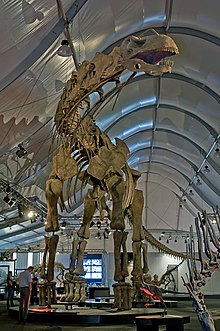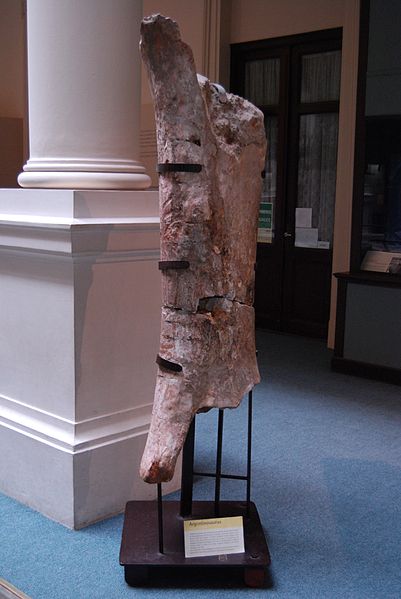Argentinosaurus is a genus of titanosaur sauropod dinosaur first discovered by Guillermo Heredia in Argentina. The generic name refers to the country in which it was discovered. The dinosaur lived on the then-island continent of South America somewhere between 97 and 94 million years ago, during the Late Cretaceous Epoch.

Reconstructed skeleton of Argentinosaurus huinculensis at the Naturmuseum Senckenberg in Frankfurt, Germany
The type species of Argentinosaurus, A. huinculensis, was described and published in 1993 by the Argentinian palaeontologists José F. Bonaparte and Rodolfo Coria. Its more specific time-frame within the Cretaceous is the late Cenomanian faunal stage, ~96 to 94 million years ago. The fossil discovery site is in the Huincul Formation of the Río Limay Subgroup in Neuquén Province, Argentina (the Huincul Formation was a member of the Río Limay Formation according to the naming of the time)

Argentinosaurus femur, Museo de La Plata.
Not much of Argentinosaurus has been recovered. The holotype included three anterior dorsal vertebrae, three posterior dorsal vertebrae, first to fifth sacrum vertebrae (only the ventral sector of the vertebral bodies), most of the sacral ribs of the right side, great part of a fragmented dorsal rib, and the right tibia. One vertebra had a length of 1.59 meters (spine to the ventral border) and the tibia was about 155 centimeters (58 inches).[1] Besides these, an incomplete femur (MLP-DP 46-VIII-21-3) is assigned to Argentinosaurus; this incomplete femur shaft has a minimal circumference of about 1.18 meters.[2] The proportions of these bones and comparisons with other sauropod relatives allow paleontologists to estimate the size of the animal.
Source: Wikipedia



 March 3rd, 2013
March 3rd, 2013  Riffin
Riffin  Posted in
Posted in  Tags:
Tags: 